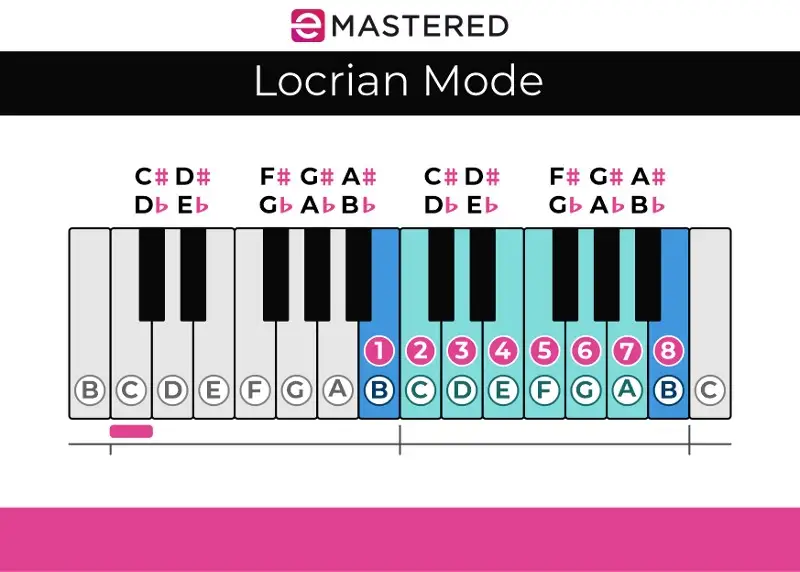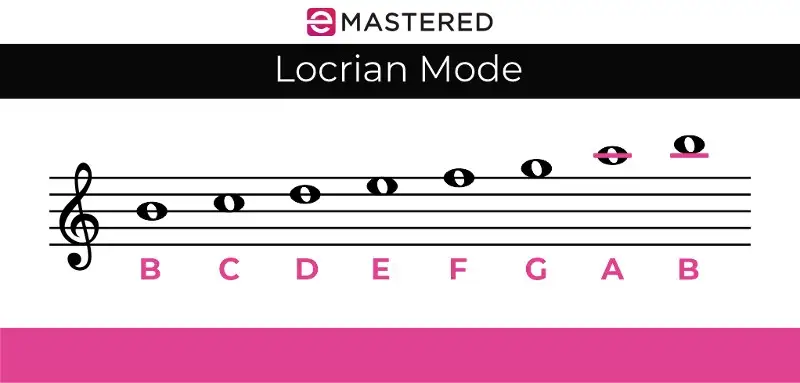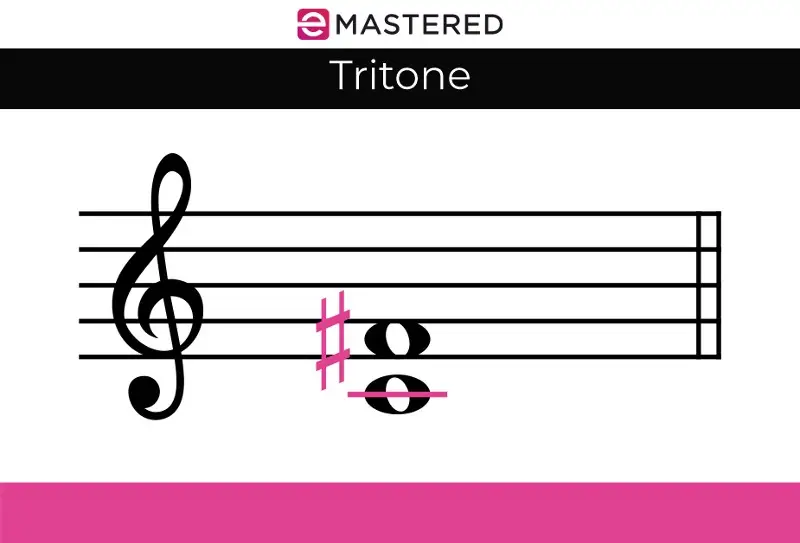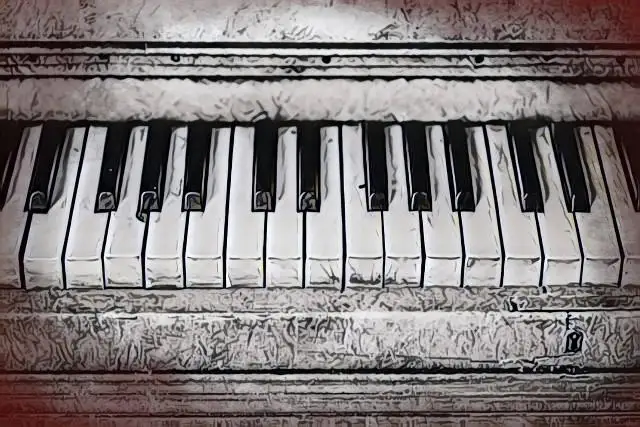Locrian mode is the seventh mode of the major scale and the last in the basic modal series. It is also probably one of the least used modes of all, meaning you likely won't see it in music pieces very often.
Even with that said, it's a very useful tool to have in your back pocket.
Today, we're going to dive in and explore the ins and outs of the Locrian mode. We'll learn what the Locrian mode is, why it's so special, and how you can use it in your music.
However, to start, let's do a quick recap on the definition of music modes.
What Are Modes?
Modes in music theory are very similar to scales. They start on a specific note and move higher or lower through the rest of the notes in the series until they come back around to the octave.
You might think of a mode like a major or minor scale.
The thing that differentiates modes from regular major or minor scales is that they have unique tonal characteristics and relationships.
You'll find seven modes in the major scale, which are based on the seven notes found within major scales.
The name of the mode depends on the note of the major scale that you start on, otherwise known as the scale degree. To give you an idea of how you derive modes from a major scale, let's look at the seven modes of the C major scale.
- C Ionian Mode - C-D-E-F-G-A-B-
- D Dorian Mode - D-F-E-G-A-B-G
- E Phrygian Mode - E-F-G-A-B-C-D
- F Lydian Mode - F-G-A-B-C-D-E
- G Mixolydian Mode - G-A-B-C-D-E-F
- A Aeolian Mode - A-B-C-D-E-F-G
- B Locrian Mode - B-C-D-E-F-G-A
What Is Locrian Mode?
Locrian mode, as you can see from the list of modes above, is the seventh and final mode in the major scale. It starts on the seventh degree of the scale.
So, for example, in the key of C major, Locrian mode begins on the note B. Because of this, we refer to the mode as B Locrian mode.
Take a look at the photo below to see what B Locrian mode looks like when played on the piano.

If we were to look at this Locrian scale as a set of tones and semi-tones, we would arrange it like this:
S-T-T-S-T-T-T
On the other hand, if we were to arrange the Locrian scale in whole and half-steps, we would arrange it like this:
H-W-W-H-W-W-W
This whole-step/half-step formula differs greatly from the major scale formula, which looks like this:
W-W-H-W-W-W-H
With the Locrian scales' whole-step/half-step formula, you can play the Locrian mode starting on any note and following the pattern.
The Scale Degrees Of The Locrian Mode
When looking at the modes of the major scale, we typically divide the bunch into major and minor modes. The Locrian mode is one of the four minor modes , including Dorian, Phrygian, and Aeolian.
The element that makes it a minor mode is the third scale degree, which is lowered by a half-step, making it a minor third.
If we had to relate Locrian mode to any of the other modes, it is most similar to Phrygian mode, thanks to the minor second. However, with the diminished fifth in the scale, it has even more of a minor quality than the Phrygian.
Let's look at the seven scale degrees found in Locrian mode:
- Root 1
- Minor Second 2
- Minor Third 3
- Perfect Fourth
- Diminished Fifth
- Minor Sixth
- Minor Seventh

Locrian has a reputation for being one of the "darkest" modes in the series, as it doesn't have any major qualities that give it relief.
With so many flattened notes, it has a very grave, sad, and minor quality to it.
Using The Locrian Mode
Let's look at a few ways you might choose to use the Locrian mode in your playing.
Using Locrian Mode In Jazz Improvisation
Jazz improvisation rarely has boundaries if you're confident enough to play the wrong notes while acting like you meant to do it.
Of course, all jokes aside, jazz leaves many open ends for unique forms of improvisation, though it truly depends on the type of jazz that you are playing. If you were playing along to a nice Billie Holiday tune, for example, it'd probably be weird if you tried to puzzle in some Locrian mode.
On the other hand, if you're experimenting with tones or playing free jazz, the chromatic characteristics of Locrian mode could work to your advantage.
Throwing that minor second into a solo right off the bat could set you up for an interesting ride. You might also give your solo a bit of an edge by using that tritone in place of a standard fifth. One of the strongest possibilities that Locrian mode holds is giving players a unique edge.
Relying On Its Dark Characteristics
One of the main reasons Locrian exists is to bring a natural form of darkness into music. Locrian receives its character from the array of flat notes, making it the darkest mode of the seven major modes.
The minor third kicks in the clearest indicator of its dark qualities, though when you add the minor second, minor sixth, and diminished fifth into the mix, you essentially get the ability to attack its darkest qualities from all angles.
It's pretty much impossible to get brightness out of Locrian mode, so if you're trying to write something bright or poppy, you're using the Locrian scale wrong. We often recommend using it in dramatic works, such as underscore for a horror film. It's wonderful for providing horror-like tension.
Play With The Tritone

Staying on this idea of darkness, the first couple of intervals found in the Locrian scale create the tritone that sits above the root or tonic. Of course, all modes have tritones somewhere , though not many of them have tritones that sit above the tonic, which is one of the things that makes this mode so interesting.
In fact, it's the only one that replaces the fifth with a diminished fifth, helping to give this mode its unique character.
With seven notes, you have a lot of options to suggest to your listener that you are using the Locrian scale. However, none of these notes can provide as much clarity as the diminished chord that uses the fifth. It's a weird feeling, as we typically use the fifth to create stability when playing. If you want to create a darker and more mysterious tone, though, the instability of the Locrian scale is what shines.
If you're a guitar player, flip on some heavy distortion and play the Locrian mode to get some aggressive melodies.
Utilize the Minor Second
After the tritone, the minor second in this scale is probably the most important element. Of course, it's important to remember that the Locrian scale isn't the only one built on this interval, as the Phrygian uses a semi-tone moving to the second as well.
Using this interval is an alternative way of providing instability besides the diminished 5th, as it makes it more difficult for a listener to determine whether the melody or song is part of a major or minor scale. Even uneducated listeners will suddenly feel that there is something tonally unique going on.
Creating Dissonance
One of my absolute favorite things about the Locrian mode is that it is super easy to create dissonance with, which makes it all the more terrifying! No matter what instrument you play, you'll be able to use the Locrian scale to create crunch, dissonant chords with this scale.
The tonic chord in the Locrian mode, for example, is completely diminished. However, you can take it even further by adding a seventh or ninth to the tonic chord to get a dim7b9 chord. It's a very similar chord to a major seven chord, though it has a more twisted characteristic.
Even beyond the tonic chord, you'll find a wide range of dissonant notes throughout the ins and outs of the Locrian scale, so make sure to explore them all as much as possible.
Examples of Locrian Mode In Music
It's pretty rare to hear the Locrian mode used in music.
Many experts say the reason is the diminished fifth scale degree, which makes it sound a bit off .
Ask people who have studied Locrian mode, and they'll tell you that people often say it feels unfinished, almost as if someone was going to continue playing but stopped abruptly.
"Jeux" - Claud Debussy
While you won't find the Locrian mode in many modern pieces of music, you can often hear it in experimental or avant-garde classical music, especially with composers who like to push the boundaries of tonality.
Claude Debussy came out with a fantastic ballet during his time, known as "Jeux." The ironic thing is that even a composer as incredible as Debussy clearly couldn't stand or didn't have the capacity to keep the piece within the Locrian scale throughout.
You'll find three distinct instances of the Locrian scale in this piece, which are quite obvious when you listen, as they are moments of serious darkness.
The interesting way Debussy approaches the Locrian mode is by using it just after using the Dorian mode. Essentially, he darkens the Dorian mode by injecting it with Locrian characteristics, slowly transitioning the piece into a darker place.
"Prelude in B Minor" - Sergei Rachmaninoff
While trying to find works entirely written in Locrian mode is pretty difficult, one of the best places to dig is within the works of 20th-century composers. Rachmaninoff offered some of the best representations of the avant-garde and modernist music movements during that time.
You'll find examples of the Locrian scale inside his "Prelude in B Minor." If you listen carefully to the piece, you'll notice that he continuously flattens the second and fifth degrees of B natural minor.
"Dust to Dust" - John Kirkpatrick
When people talk about the use of the Locrian scale in modern music, one of the most common examples that you hear is "Dust to Dust" by folk singer John Kirkpatrick.
The unique thing about "Dust to Dust" is that Kirkpatrick does not have any accompaniment. The song is only of his voice and the matching accordion, which is probably the most impressive thing, considering the fact that he is able to so effortlessly explore the Locrian scale.
While it might sound like your traditional folk song at first listen, you'll hear a few strange intervals that give it an edge, differentiating it from other folk pieces of the time.
Though this track is very unconventional in the world of folk music, it is one of the best examples of someone using a melody where they never bring the final notes to a resolve.
"Rational Gaze" - Meshuggah
We'd be remiss if we didn't talk about the use of the Locrian mode in metal music, as it is often used in heavier metal genres, thanks to its demonic characteristics. Listen to many metal songs, and you'll hear the mode utilized over and over again for its dissonant qualities.
One of our favorite examples of a metal piece using the Locrian scale is "Rational Gaze" by Meshuggah. The beauty of this track is that it exemplifies the sheer ferocity and power that you can get from a Locrian-based guitar riff.
Meshuggah writes some extremely heavy songs using technical prowess and intricate playing. The opening of this particular song focuses on the minor 2nd and diminished 5th intervals to provide the listeners with a bit more intensity.
Final Thoughts - Unlocking The Mysteries of Locrian Mode
Though Locrian mode is one of the darkest and least favorable diatonic modes (at least in popular music), it can be a unique tool to have in your back pocket for when you need to contrast a brighter piece or write something that feels minor or diatonically incomplete.
To get a feel for the Locrian mode, start by playing B on the piano and move along the white notes until you get to the B above. You'll notice this incomplete feeling once you get to the final B, as you'll almost want it to keep going to C.
As you get more used to hearing the Locrian scale, begin using it in your songs for its uniquely dark identity. Whether you're scoring dramatic films or writing the next best shred metal track, the Locrian mode offers a unique emotive intensity that you'd be hard-pressed to find anywhere else.
We hope that you experiment and try to use the Locrian mode in your music or in your studies.





